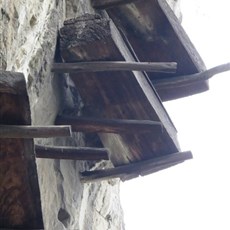1 May,
Luobiao to Yibin
Hanting Express 146CNY
We
travelled to out-of-the-way Luobiao
to view the “Mysterious Hanging Coffins of the Bo”. We took scooter taxis to the
site entrance, then, in a light drizzle, walked a loop through a valley between
cliffs. It is on the cliff face that the coffins of the dead Bo are suspended.
“According
to Cui Chen, curator of the Yibin Museum, hanging coffins come in three types.
Some are cantilevered out on wooden stakes. Some are placed in caves while
others sit on projections in the rock ... Survey reports from the early 1990s
show Gongxian County having a total of 280 hanging coffins. However in the past
10 years or so nearly 20 have fallen. The coffins were hung at least 10 meters
above the ground with the highest ones reaching 130 meters ... The Bo people
have become lost in the pages of the history of human civilization ... Cliff
paintings were also found. These are of great significance to the study of the
lives, work, politics, military affairs and culture of the Bo People ... The Bo
were an ethnic minority people living astride the borders of modern day Sichuan
and Yunnan provinces. There they created a brilliant culture as early as 3,000
years ago ... The Bo differed from other ethnic groups in their burial customs.
Typically hewn from durable hardwood logs, their hanging coffins went
unpainted. The most recent hanging coffins were made up to about 400 years ago
in the middle and later periods of the Ming Dynasty (1368-1644), while many of
the earliest ones date back 1,000 years to the Song Dynasty (960-1279). To
date, the earliest hanging coffin was one found in the Three Gorges area,
dating back about 2,500 years to the Spring and Autumn Period (770 BC- 476 BC)
... The hanging coffin was the most widespread form of burial in ancient
southwest China. However, the practice ended with the mysterious disappearance
of the Bo People. Those who came after knew them from the hanging coffins and
the paintings they left behind like faint echoes on the cliffs ... Why did the
Bo people bury their dead so high? Li Jing writing during the Yuan Dynasty
(1279-1368) offers a clue in his Brief Chronicles of Yunnan. “Coffins set high
are considered auspicious. The higher they are the more propitious for the dead
...” ... Cui Chen who is Curator of the Yibin Museum examines three different
ways the coffins could have been put in place. “Earth ramps might have been
used but experts discount this solution due to the extent of the labor
required, which would have been difficult in an under-populated area. A timber
scaffold supported on stakes in the cliff might have offered a plausible
explanation but years of investigation have failed to find even a single stake
hole. On balance the third option of lowering the coffins on ropes from above
had always seemed feasible and now cultural specialists have found the telltale
marks of the ropes which were used all these years ago. And so this part of the
mystery of the hanging coffins has now been resolved.” ... During the later
years of the Ming Dynasty, the imperial army cruelly oppressed the ethnic
minority peoples of Sichuan and Yunnan. In particular, the Duzhangman and Bo
Peoples fell, victims of massacre. To escape their oppression, the Bo migrated
to new locations. They hid their real names and integrated into other ethnic
groups. Like their culture they have disappeared but their descendents are
still here for they are a part of us.” (China.org.cn)
Yibin
sits at the confluence of the Min and Yangzi rivers. It is an attractive town
and particularly vibrant on a May Day holiday evening.

Hanging coffins outside Luobiao

Hanging coffins outside Luobiao

Hanging coffins outside Luobiao

Hanging coffins outside Luobiao

Hanging coffins outside Luobiao

Hanging coffins outside Luobiao

Hanging coffins outside Luobiao

Hanging coffins outside Luobiao

Hanging coffins outside Luobiao

Hanging coffins outside Luobiao

Hanging coffins outside Luobiao

Hanging coffins outside Luobiao

Hanging coffins outside Luobiao

Yibin

Yibin

Yibin

Yibin

Yibin